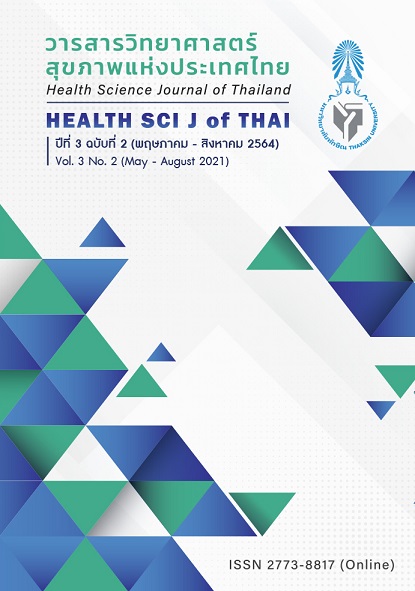ความสัมพันธ์ระหว่างการดื้อยาต้านจุลชีพกับการบริโภคยาต้านจุลชีพในโรงพยาบาลกระบี่
Main Article Content
บทคัดย่อ
การดื้อยาต้านจุลชีพเป็นภัยคุกคามที่สำคัญทั่วโลก การวิจัยนี้มีวัตถุประสงค์เพื่อศึกษาแนวโน้มการดื้อยาต้านจุลชีพของเชื้อแบคทีเรียและศึกษาความสัมพันธ์ของการใช้ยาต้านจุลชีพและการดื้อยาต้านจุลชีพในโรงพยาบาลกระบี่ ผลการทดสอบความไวของแบคทีเรียต่อยาต้านจุลชีพและปริมาณการใช้ยา ปี 2562-2556 วิเคราะห์สัดส่วนเชื้อแบคทีเรียดื้อต่อยาต้านจุลชีพและหาความสัมพันธ์กับปริมาณการใช้ยาต้านจุลชีพ ผลการศึกษาพบว่า เชื้อแบคทีเรีย Pseudomonas aeruginosa มีความไวต่อยา Amikacin ในทิศทางที่เพิ่มขึ้น โดยร้อยละของเชื้อที่ดื้อต่อยาดังกล่าวลดลงอย่างมีนัยสำคัญทางสถิติ (p = 0.042) สำหรับเชื้อ Escherichia coli มีความไวต่อยา Piperacillin และ Ertapenem ลดลงมากกว่า 10 เท่า โดยพบเชื้อที่ดื้อต่อยา Piperacillin เพิ่มขึ้นจากร้อยละ 0.66 เป็น 8.57
(p = 0.004) และเชื้อที่ดื้อต่อยา Ertapenem เพิ่มขึ้นจากร้อยละ 0.19 เป็น 7.38 (p = 0.030) ปริมาณการใช้ยา Amikacin, Cefotaxime และยา Norfloxacin ลดลงอย่างมีนัยสำคัญทางสถิติ (p = 0.027, 0.006 และ 0.037) ส่วนยา Ceftazidime, Piperacilin/Tazobactam และ Ertapenem มีแนวโน้มการใช้ยาในปริมาณที่เพิ่มขึ้นอย่างมีนัยสำคัญทางสถิติ (p = 0.018, 0.006 และ 0.030) และพบว่าเชื้อแบคทีเรีย Escherichia coli มีความสัมพันธ์ในทิศทางเดียวกันระหว่างร้อยละของเชื้อดื้อยาและปริมาณการใช้ยา Meropenem และยา Piperacilin/Tazobactam (r = 0.96, p < 0.001 และ r = 0.79, p=0.036)
Article Details

อนุญาตภายใต้เงื่อนไข Creative Commons Attribution-NonCommercial-NoDerivatives 4.0 International License.
เอกสารอ้างอิง
Chanvatik, S. Surveillance of antimicrobial consumption in Thailand: A foundation for controlling antimicrobial resistance. HSRI Journal 2017; 11(5): 593-607. (in Thai).
The national strategic plan on antimicrobial resistance 2017-2021 Thailand [Internet]. c2016 [cited 2017 Dec 10]. Available from: http://narst.dmsc.moph.go.th/documentation/AMR%20strategy%202560-2564.pdf. (in Thai)
Antimicrobial resistance. Antimicrobial resistance-tackling a crisis for the health and wealth of nations [Internet]. 2014 [cited 2017 Dec 10]. Available from: https://amr-review.org/sites/default/files/AMR%20Review%20Paper%20%20Tackling%20a%20crisis%20for%20the%20health%20and%20wealth%20of%20nations_1.pdf.
Olusoji, O.A., Enis, B., Olga, B.J., Alec, I., Berthe, FCJ., Francois, L.G., et al. Drug-resistant infections a threat to our economic future. Executive summary. Washington: International Bank for Reconstruction and Development/the World Bank; 2017 Oct. Report No.: 114679.
United Nations meeting on antimicrobial resistance [Internet]. Bull World Health Organ; 2016 [cited 2017 Dec 10]. Available from: http://www.who.int/bulletin/volumes/94/9/16-020916.pdf/ doi:10.2471/ BLT.16.020916.
Holmes, A.H., Moore, L.S.P., Sundsfjord, A, Steinbakk, M., Regmi, S., Karkey, A., et al. Understanding the mechanisms and drivers of antimicrobial resistance. Lancet. 2016; 387: 176–87.
Grigoryan, L., Burgerhof, J.G.M, Degener, J.E., Deschepper, R., Lundborg, C.S., Monnet, D.L, et al. Determinants of self-medication with antibiotics in Europe: the impact of beliefs, country wealth and the healthcare system. Antimicrob Chemother. 2008; 61(5): 1172–9.
Hunter, P.A., Dawson, S., French, G.L., Goossens, H., Hawkey, P.M., Kuijper, E.J., et al. Antimicrobial-resistant pathogens in animals and man: prescribing, practices and policies. J Antimicrob Chemother. 2010; 65 Suppl 2: I3–17.
Huttner, B., Goossens, H., Verheij, T., & Harbarth, S. Characteristics and outcomes of public campaigns aimed at improving the use of antibiotics in outpatients in high-income countries. Lancet Infect Dis. 2010; 10(1): 17–31.
Plachouras, D., Kavatha, D., Antoniadou, A., Giannitsioti, E., Poulakou, G., Kanellakopoulou, K., et al. Dispensing of antibiotics without prescription in Greece, 2008: another link in the antibiotic resistance chain. Euro surveillance. 2010; 15 (7): 4–7.
Goossens, H., Ferech, M., Vander, S.R., & Elseviers, M. Outpatient antibiotic use in Europe and association with resistance: a cross-national database study. Lancet. 2005; 365: 579–87.
World Health Organization. Global action plan on antimicrobial resistance. World Health Organization [Internet]. 2015. [cited 2018 Aug 24]. Available from: http://www.pro.who.int/entity/drug_resistance/resources/global_action_plan_eng.pdf.
World Health Organization. Evaluation of antibiotic awareness campaigns [Internet]. Report 2016. Geneva: Expert Committee on the selection and use of essential medicines policy, access and use (PAU); 2016. [cited 2018 Apr 1]. Available from: http://www.who.int/selection_medicines/committees/expert/21/applications/s6_antibiotic_ awareness_campaigns.pdf.
Chaintarli, K., Ingle, S.M., Bhattacharya, A., Ashiru-Oredope, D., Oliver, I., & Gobin, M. Impact of a United Kingdom-wide campaign to tackle antimicrobial resistance on self-reported. 2019.
Chaiyasong, C., Tayapak, P., Pinake, S., & Chaiyasong, S. Associations between antibiotic use and resistance in Mahasarakham Hospital. IJPS. 2019;15(2). 98-105.


